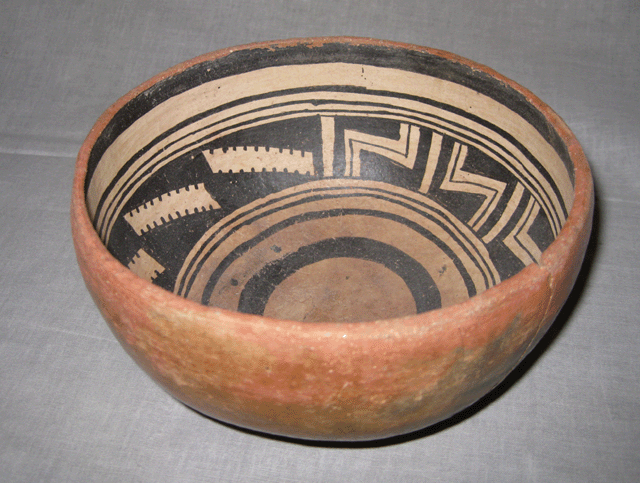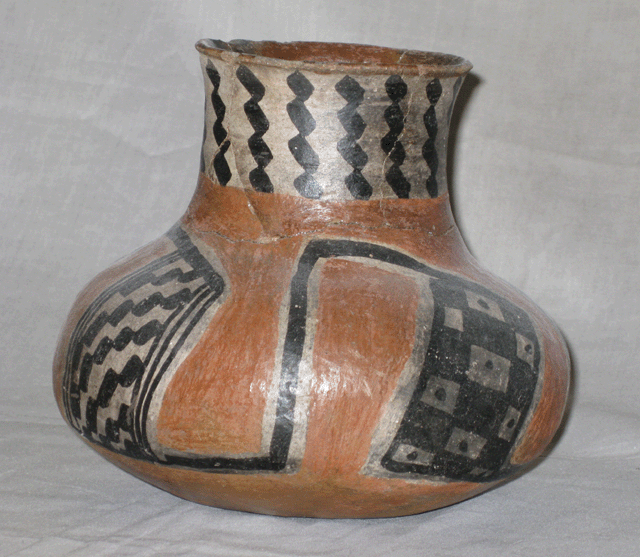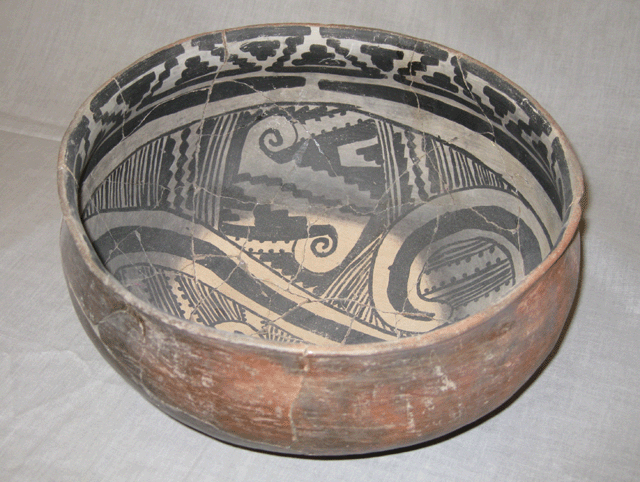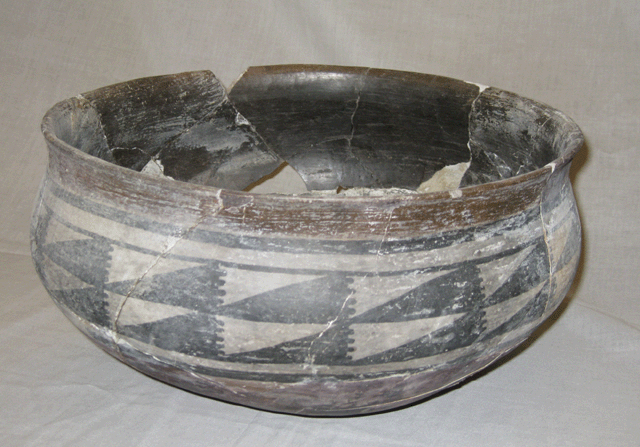
Roosevelt Red Ware
Encyclopedia

Pottery
Pottery is the material from which the potteryware is made, of which major types include earthenware, stoneware and porcelain. The place where such wares are made is also called a pottery . Pottery also refers to the art or craft of the potter or the manufacture of pottery...
tradition found across large portions of Arizona
Arizona
Arizona ; is a state located in the southwestern region of the United States. It is also part of the western United States and the mountain west. The capital and largest city is Phoenix...
and New Mexico
New Mexico
New Mexico is a state located in the southwest and western regions of the United States. New Mexico is also usually considered one of the Mountain States. With a population density of 16 per square mile, New Mexico is the sixth-most sparsely inhabited U.S...
. The tradition
Archaeological culture
An archaeological culture is a recurring assemblage of artifacts from a specific time and place, which are thought to constitute the material culture remains of a particular past human society. The connection between the artifacts is based on archaeologists' understanding and interpretation and...
involves the combination of red, white, and black paint
Paint
Paint is any liquid, liquefiable, or mastic composition which after application to a substrate in a thin layer is converted to an opaque solid film. One may also consider the digital mimicry thereof...
in varying configurations along with compositional and morphological characteristics. This ceramic tradition begins about AD 1280-1290 and lasts until at least AD 1450 based on tree-ring
Dendrochronology
Dendrochronology or tree-ring dating is the scientific method of dating based on the analysis of patterns of tree-rings. Dendrochronology can date the time at which tree rings were formed, in many types of wood, to the exact calendar year...
dating.
History
Archaeologists have argued over the nature of Salado as a cultural phenomenon or an ideological one spreading through the Southwest. Some archaeologists have chosen to use the term Salado Polychromes so as not to give undue emphasis to the Roosevelt Lake area, once thought to be the center of production. Both terms, Salado Red Ware and Roosevelt Red Ware are still used by archaeologists.In her 1994 volume, Dr. Patricia Crown suggested four models with which to analyze Salado Polychromes. They are "elite symbols of authority or items of exchange," "indicators of participation in an economic alliance/regional system," "objects associated with the spread of a religious ideology," and as "markers of ethnicity for a migrant group" (Crown 1994: vi). More recently archaeologists have examined these types distribution across the Southwest (Lyons 2003) and suggests that these types are markers of migrant groups emanating from northeastern Arizona.
Ceramic typology
Roosevelt Red Ware is divided by archaeologists into a series of typesTypology (archaeology)
In archaeology a typology is the result of the classification of things according to their characteristics. The products of the classification, i.e. the classes are also called types. Most archaeological typologies organize artifacts into types, but typologies of houses or roads belonging to a...
, which cover shorter spans of time, based on configurations of the painted designs and rim profiles of bowls.
Roosevelt Red Ware has traditionally been organized into three types based on stylistic differences. More recently researchers at the Center for Desert Archaeology in Tucson, Arizona have identified an additional six types based on a combination of stylistic and morphological characteristics. For bowls with both interior and exterior decoration, the exterior style is labeled as the variant (Example: Gila interior with a Tonto exterior would be labeled as Gila Polychrome: Tonto Variant)
All types within this ware share a number of broad categorical similarities although over a roughly 250 year time span significant variation is seen. The paste is generally brown to reddish-brown in color and is tempered with sand. Generally red and/or white slip cover both the interior and exterior and black paint is used on one or both surfaces, usually surrounded by white rather than red slip. Black paint is most commonly organic, but a mixture of organic and mineral paint appears on some vessels. Petrographic analyses have shown that Roosevelt Red Ware is produced across the full distributional range.
Pinto Polychrome
Pinto Polychrome is the earliest of the Roosevelt Red Wares and dates from AD 1280 to 1330. Pinto Polychrome vessels are only found in the form of bowls and lack the banding line, also called a "life-line" by some authors, that identify Gila Polychrome. Stylistically Pinto Polychrome is reminiscent of St Johns Polychrome in its layout of opposed hatched and solid elements, although the type exhibits a period of experimentation with colors and layouts that continue through subsequent types.Pinto polychrome is found along the Mogollon Rim
Mogollon Rim
The Mogollon Rim is a topographical and geological feature running across the U.S. state of Arizona. It extends approximately from northern Yavapai County eastward to near the border with New Mexico.-Description:...
in Arizona as well as the Tonto Basin
Tonto Basin
The Tonto Basin, also known as Pleasant Valley, covers the main drainage of Tonto Creek and its tributaries in central Arizona, at the southwest of the Mogollon Rim, the higher elevation transition zone across central and eastern Arizona....
, Sierra Ancha
Sierra Ancha
The Sierra Ancha is a mountain range in Gila County, in central Arizona. It lies between Roosevelt Lake to the south, the Tonto Basin to the west, Cherry Creek to the east, and Pleasant Valley to the north...
, Globe Highlands, San Pedro Valley
San Pedro Valley (Arizona)
The San Pedro Valley of western Cochise County Arizona is a 50 mile long, mostly north-south valley, trending northwesterly. It drains from Sierra Vista Southeast north towards I-10, Benson, and the southeast of the Rincon Mountains....
, Point of Pines Area
Point of Pines Sites
Point of Pines Sites is a set of archaeological sites in the U.S. state of Arizona that are significant for associations with Anasazi, Mogollon and Hohokam cultures. The sites were chosen as a field school location by Dr...
, Kinishba Area
Kinishba Ruins
Kinishba Ruins is a sprawling, 600-room great house archaeological site in eastern Arizona and is administered by the Southern Athabaskan-speaking White Mountain Apache Tribe of the nearby Fort Apache Indian Reservation...
and the Upper Gila Valley (Neuzil and Lyons 2005: 34).
There is a transitional variant that has been noted by some authors known as Pinto-Gila Polychrome. This type exhibits the more bold designs generally found in Gila Polychrome but lacks the banding line and is still only found in bowls. Some authors have chosen not to use this type arguing that types tend to blur in transitional periods between types and that adding types adds no additional analytical usefulness. Pinto Polychrome is also contains a Salmon Variety (see Gila Polychrome).
Pinto Black-on-red
Similar in dates, designs, and geographic distribution to Pinto Polychrome but without the white slip underlying black paint.Gila Polychrome

Gila Polychrome is produced from about AD 1300-1450 across Arizona, New Mexico and northern Mexico, north of Casas Grandes, Chihuahua.
Gila Black-on-red
Similar in dates, designs and geographic distribution to Gila Polychrome but without the white slip underlying black paint.Tonto Polychrome
Tonto Polychrome is found in higher frequencies on jars. The black on white designs are generally narrower bands than on Gila jars, or panels of decoration, and are surrounded by red slip. This type has a later starting date than Gila Polychrome, AD 1340 and an end date of 1450.Cliff Polychrome

This type is found in bowl form and can be partially identified by recurved and semi-flaring rims. Accompanying the shift in bowl shape is a drop in the banding line, creating a secondary design field between the banding line and the rim. Design elements otherwise are similar to those found on Gila and Tonto Polychrome vessels.
Lyons (2004) describes the spatial distribution for this type as ranging from Petrified National Forest, Arizona to Casas Grandes
Casas Grandes
Casas Grandes is the contemporary name given to a pre-Columbian archaeological zone and its central site, located in northwestern Mexico in the modern-day Mexican state of Chihuahua. It is one of the largest and most complex sites in the region...
, Chihuahua, Mexico and from the Phoenix basin to Alamogordo, New Mexico
Alamogordo, New Mexico
Alamogordo is the county seat of Otero County and a city in south-central New Mexico, United States. A desert community lying in the Tularosa Basin, it is bordered on the east by the Sacramento Mountains. It is the nearest city to Holloman Air Force Base. The population was 35,582 as of the 2000...
. The locus of heaviest production for this type seems to be centered around southeastern Arizona and southwestern New Mexico possibly indicating the location of origin for this type. Temporal distribution would seem to indicate that this type is temporally significant since sites exist throughout the distributional range containing both Gila and Tonto Polychrome, but lacking Cliff Polychrome.
Nine Mile Polychrome
Nine Mile Polychrome is similar to Cliff Polychrome in that it only occurs in bowls with a recurved rim with a black-on-white band of design on the bowl interior just below the rim, the area above the banding line on Cliff Polychrome. Unlike Cliff Polychrome however, the rest of the interior of this type is red slipped without any additional elaboration, including lack of a banding line. Generally Nine Mile Polychrome vessels have either a Gila or Tonto Polychrome exterior decoration. This type is found in the region from the Cliff Valley to Perry Mesa, and from the Middle Verde Valley to the area around Douglas, Arizona. While rare, this type seems to have its greatest density around the far southeastern portion of its distribution. This type dates from the timer period AD 1375-1450 (Neuzil and Lyons 2005).This type is named for the Nine Mile Site in the San Simon Valley
San Simon Valley
The San Simon Valley is a broad valley east of the Chiricahua Mountains, in the northeast corner of Cochise County, Arizona and southeastern Graham County, with a small portion near Antelope Pass in Hidalgo County of southwestern New Mexico. The valley trends generally north-south but in its...
excavated by Jack and Vera Mills in the 1940s.
Phoenix Polychrome
Phoenix Polychrome also occurs only in bowls with recurved rims. This type is similar to Nine Mile Polychrome with the difference being that Phoenix Polychrome lacks the band of black on white decoration on the interior of bowls and is instead entirely covered in red slip. As with other types, the exterior of these bowls may have either Gila or Tonto style decoration.This type dates to AD 1375-1450 and as the name suggests its distribution centers on the Phoenix basin, but distribution extends east to the Cliff Valley and is extends from the Verde Valley in the north to the Douglas, Arizona area in the south (Neuzil and Lyons 2005).
Dinwiddie Polychrome

Dinwiddie Polychrome has a very restricted spatial distribution and may "not occur west of a line drawn through Kinishba, near Whiteriver, and the Nine Mile site, near Bowie
Bowie, Arizona
Bowie is an unincorporated community in Cochise County, Arizona. The community lies on Interstate 10 in eastern Arizona close to the western New Mexico border...
[Arizona]" (Neuzil and Lyons 2005: 30). In Crown’s 1994 study, although she did not name this type, she noted that Roosevelt Red Ware bowls exhibiting smudged interiors were confined to a limited geographical range.
Los Muertos Polychrome
Los Muertos Polchrome has a long and storied history of recognition without formal description. Neuzil and Lyons (2005) note that archaeologists have noted this type as a variation of Gila Polychrome since 1927. Names under which this type has been known include Gila Polychrome with four colors, Las Colinas Polychrome, Perry Mesa Polychrome, Gila style with red, and Gila Polychrome; Trichrome Variety.This type is identified by red paint used in conjunction with black paint in white design fields. Design layout follows either Gila or Tonto styles and so is referred to with reference to either of these varieties. Distribution of this type is limited to the Verde Valley, the Agua Fria-Perry Mesa area, the Lower Salt River Valley, the Middle Gila, the Santa Cruz Flats, and the Tonto Basin (Neuzil and Lyons 2005: 30-31).
Cliff White-on-red
Cliff White-on-red is also a recurved bowl form of Roosevelt Red Ware. The interior of the vessel is smudged on the interior and the exteriors exhibit the white-on-red decoration. Cliff White-on-red overlaps in distribution with Dinwiddie Polychrome and thus the range appears to be southwestern New Mexico and southeastern Arizona.Similar white-on-red types exist in the Southwest, although all show sufficient differences for Cliff White-on-red to hold up as a distinct type. This type is different from Gila White-on-red in that Cliff White-on-red is thinned by scraping rather than paddle-and-anvil, and designs are broader than those found on Gila White-on-red. Unlike Cliff White-on-red, Salado White-on-red is white decoration on a red-slipped obliterated corrugated body. Finally, Tularosa White-on-red is most similar to Cliff White-on-red with a smudged interior and a recurved rim form. The differences are that Tularosa White-on-red has two to four coils around the neck and thinner lines used in the designs. (Neuzil and Lyons 2005)
Mexican Forms

A second type, as of yet unnamed, is similar to Escondida Polychrome but exhibits the white slip found on Roosevelt Red Ware. Fenner (personal communication) feels that these vessels are most likely locally produced Roosevelt Red Wares and as such would be found under one of the above headings, although sherds would exhibit the buff colored paste found in the region.

